Have you seen your indoor cat longingly looking out the window? Mine certainly have. They're keenly observing birds and squirrels, visibly eager for an adventure beyond the boundaries of their glass barrier.
This curiosity prompted me to investigate outdoor cat climbing walls and shelves.
I discovered a brilliant concept from Pamela Reed: utilizing high-quality shelves from Home Depot to create lively cat furniture that has the strength to bear up to 50 pounds. Equipped with a screwdriver, level, and some carpet for extra stability, one can easily construct an exceptional playground right in the backyard.
Do you want to provide your furry companion with their ideal outdoor escapade? Let's embark on this journey—your kitty's new adventure is ready to begin!
Key Takeaways
- Use weather-resistant wood like cedar for outdoor cat shelves. It lasts long and keeps pests away.
- Secure the climbing wall with heavy-duty fasteners to ensure it's safe for your cat.
- Add fun features like hammocks, cubbies, and tunnels to make the climbing wall more exciting.
- Regularly clean and check the shelves for wear or damage to keep them safe.
- Weatherproof your materials so they last longer outside against rain and sun.
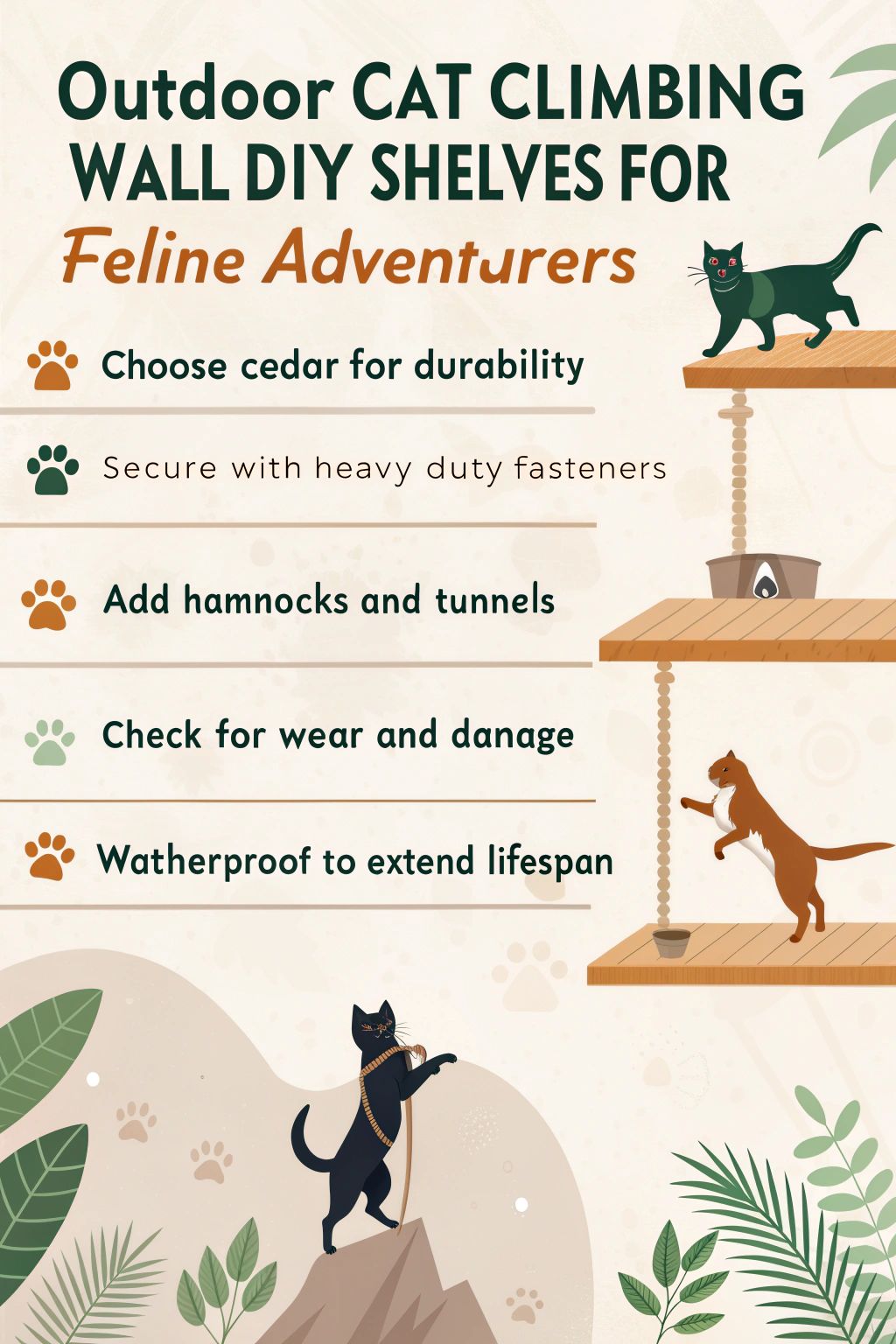
Essential Materials for Building Cat Shelves
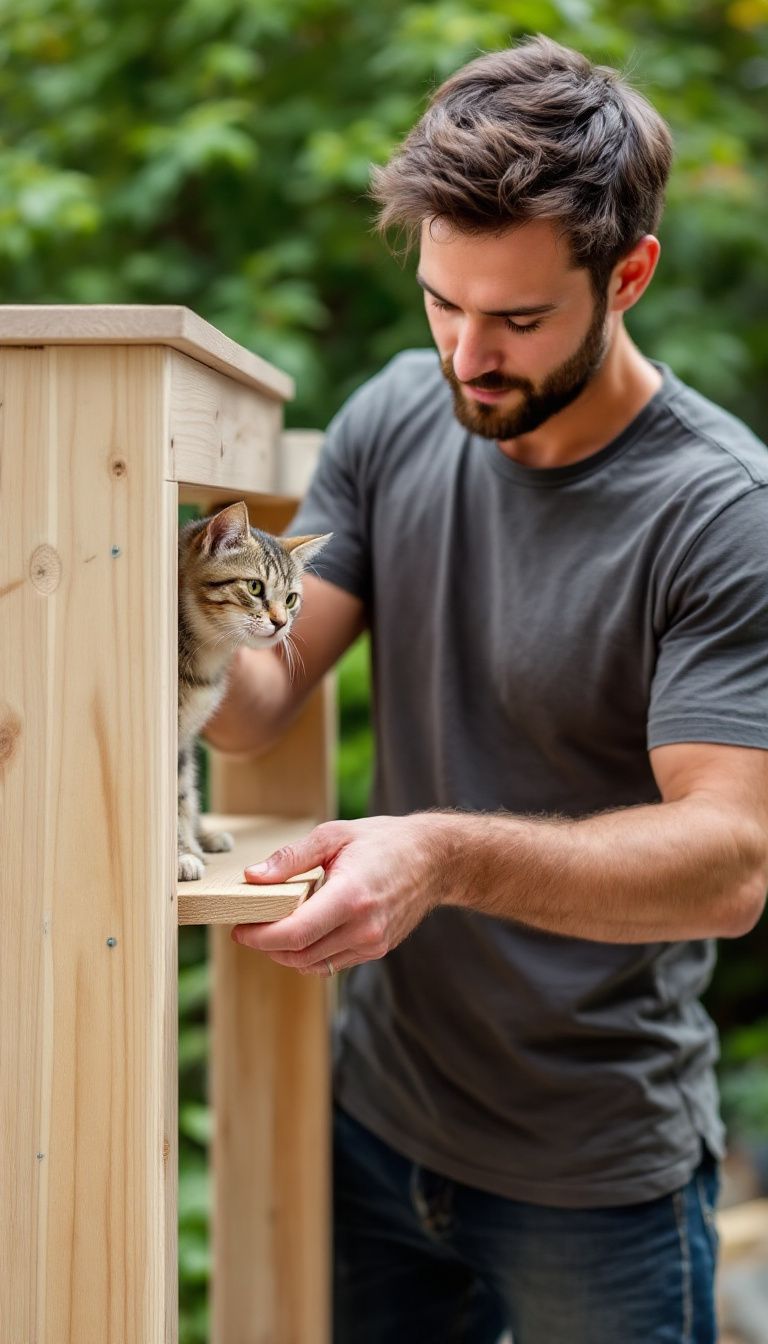
For outdoor cat shelves, choosing the right materials matters a lot. You need weather-resistant wood and strong fasteners to make sure your cat's new play area stays safe and sturdy over time.
Types of wood suitable for outdoor use
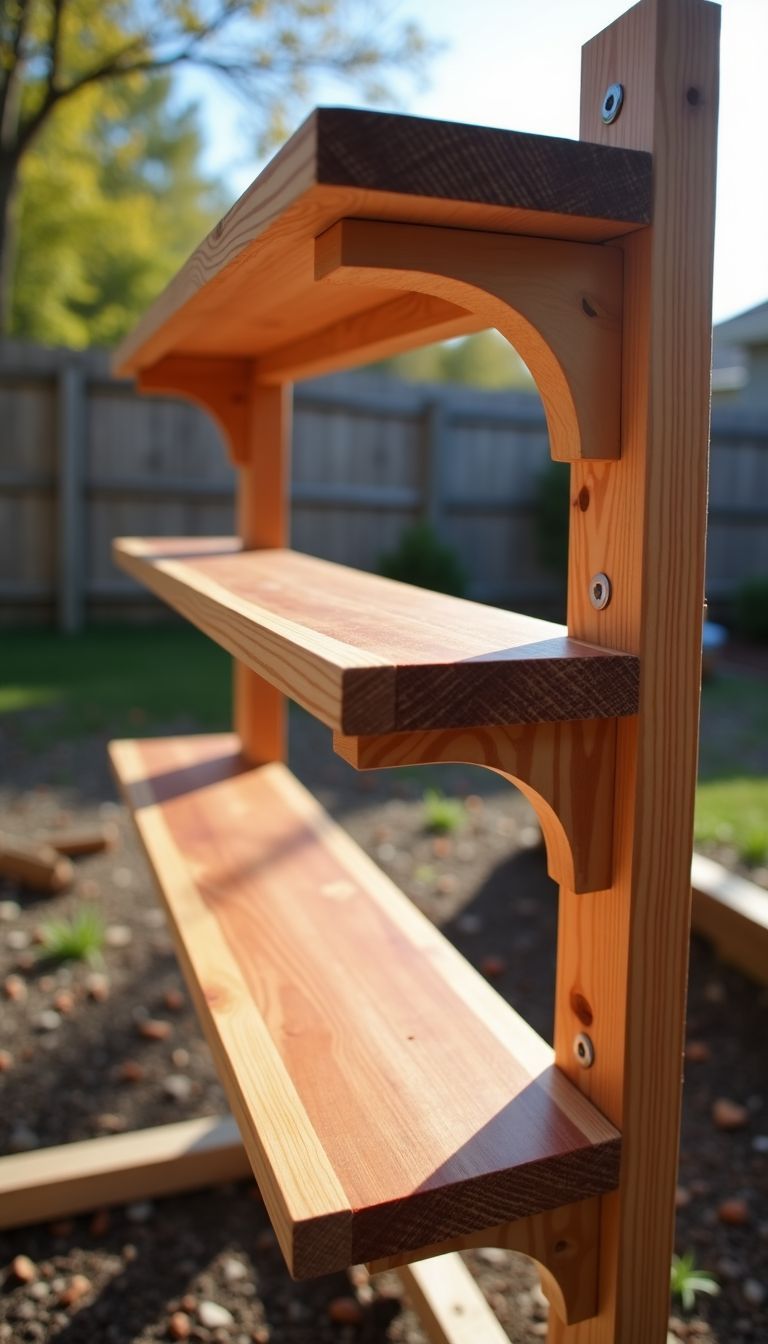
Cedar is my preferred choice when it comes to creating open-air shelves for cats. The reasons? Its long-lasting resistance to weather conditions, resistance to decay, and its natural deterrent to pests such as fleas without the use of strong chemicals.
Within the United States there are five cedar variations – Western Red Cedar, Northern White Cedar, Eastern Red Cedar, Yellow Cedar, and Spanish Cedar. Each type brings its own advantages, yet all possess shared attributes that make them excellent for the climbing walls of our cat companions.
The Western Red Cedar distinguishes itself through its strength and lightweight nature. It also maintains a pleasing appearance over time, even when exposed to the elements outdoors.
This particular cedar is also recognized with an Environmental Product Declaration (EPD), signifying it is harvested in a manner that is beneficial to our environment. Thereby, the use of this wood is a win-win, gratifying your cat and simultaneously promoting forest conservation.
Having identified the most appropriate woods for external use, the next topic of discussion is the necessary components for the assembly of these shelves – reliable fasteners and supports are up next…
Durable fasteners and supports
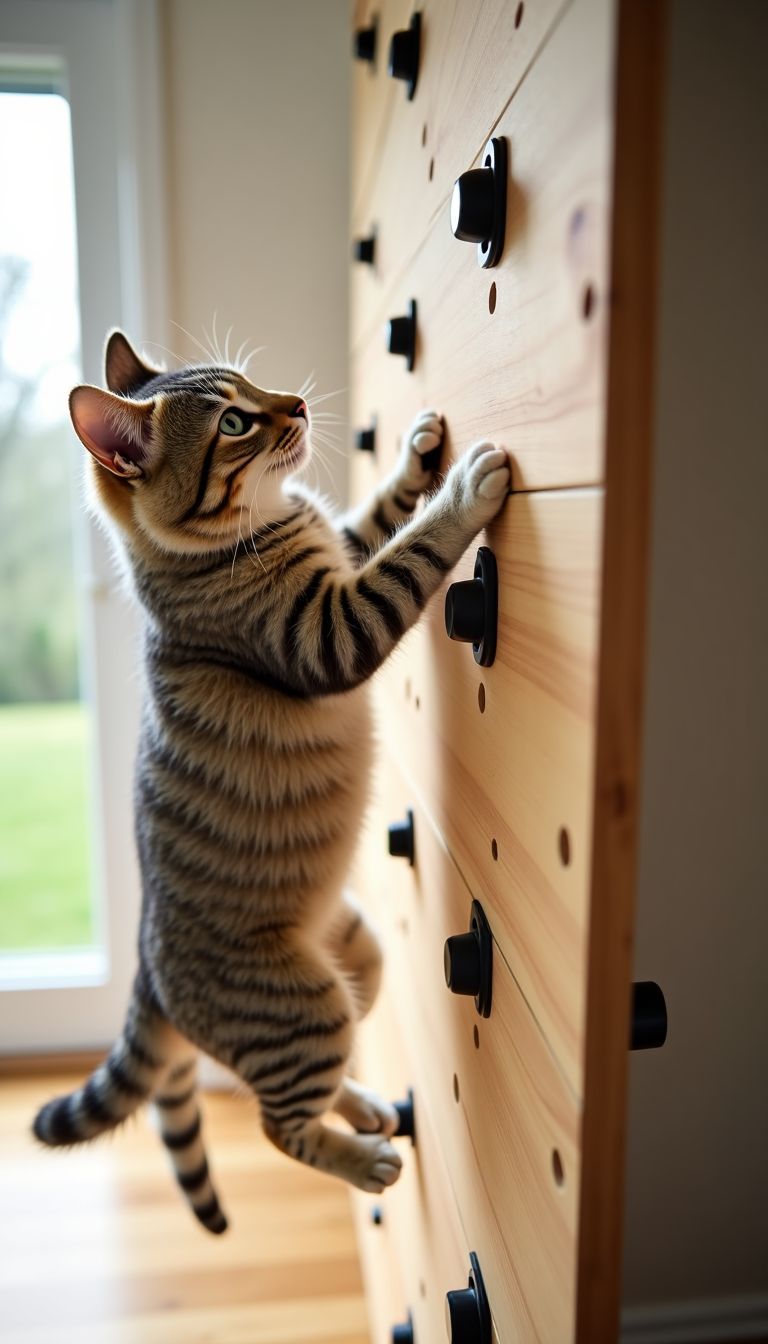
Building a sturdy cat climbing wall needs the right fasteners and supports. I always choose heavy-duty wall anchors that go into the wall studs. These provide strong support for those little climbers.
Sturdy “L” brackets work great, too. Their sides should be at least half the depth of your wooden board.
Use wood screws that are just long enough to attach securely to the brackets. For longer boards, I place support brackets every 16 inches to keep everything stable. It’s important to make sure each board is at least 12 inches long when mounted…
this helps prevent any wobbling or tipping over during playtime.
“Safety first means more fun for my feline friends.”
Step-by-Step Guide to Building a Basic Cat Climbing Wall

Building a cat climbing wall can be fun and simple. Start by preparing your wood properly, then assemble the structure step-by-step to create a safe play space for your kitty.
Preparing the wood
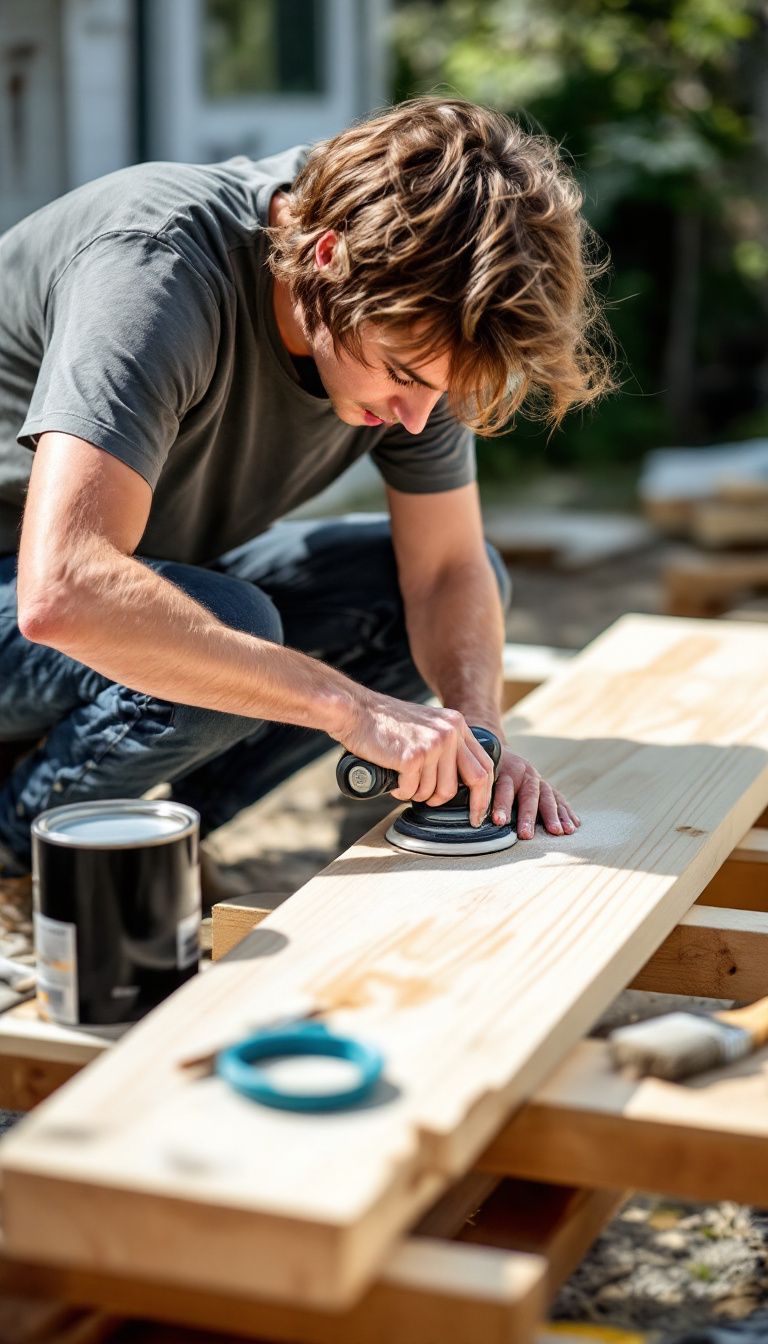
I start preparing the wood by taking two pine boards, each 1″ x 12″ x 8′. I sand them down to remove rough spots. This makes the surface safe for my cats. Next, I measure and cut as needed, ensuring each shelf fits just right.
It's also smart to stain the wood. Staining helps protect it from rain and sun damage. Finally, I clean up any dust or debris before moving on. My focus is on creating a sturdy base for my climbing wall…
then I'll assemble the structure next!
Assembling the structure
Assembling the structure is simple and fun. First, I lay out my wood pieces on a flat surface. It’s important to measure spacing for jumping. Cats love to leap! I use sturdy brackets to attach each shelf securely to the wall.
This keeps everything safe for my feline friends.
Next, I make sure all fasteners are tight. Safety is key here; nobody wants a shelf falling down while my cat plays! Sometimes, my cat likes to “help” with this part—supervising from below or even climbing nearby.
After that, I check everything one more time before moving it outside. Solid support means happy cats!
Securing the wall to an outdoor location
Securing the wall is key for safety. I find a sturdy outdoor spot. The area should be flat and free of obstacles. Then, I use brackets or heavy-duty screws to attach the shelves to a solid surface, like brick or wood.
Next, I make sure each shelf can hold my cat's weight. It's important to test them before letting my cat climb up! Strong fasteners keep everything in place, even when it storms outside.
Weatherproof options are best—this protects against rain and sun damage too.
Lastly, checking the structure often helps avoid accidents. Regular inspection is smart—I look for any loose parts or wear and tear on the wood and fasteners… This way, my furry friend stays safe while exploring her climbing adventure!
Creative Designs for Cat Climbing Walls
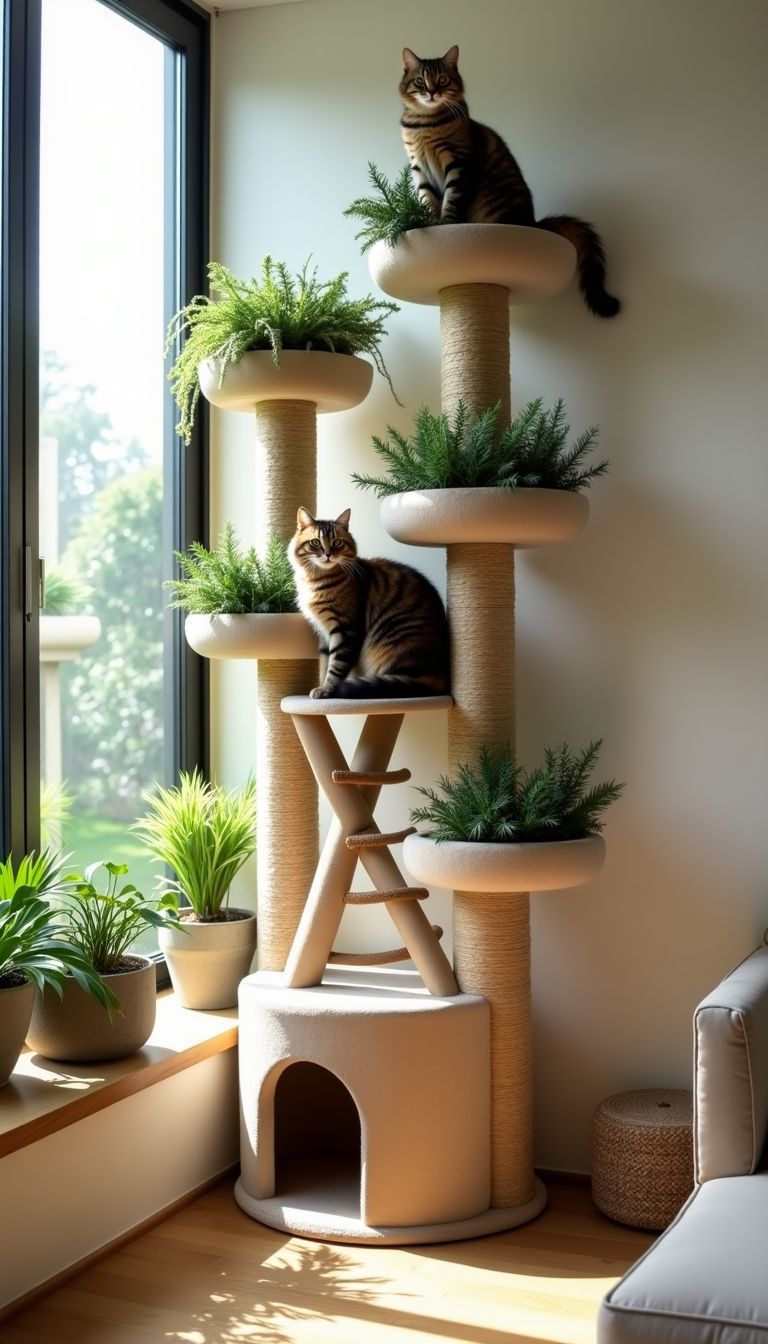
Cats love to climb. You can create fun spots for them with cool designs.
Multi-layered climbing stations let your cat explore high and low. Greenery perches bring nature close to home, giving cats a nice place to relax… Try adding spiral steps or scratch posts!
Multi-layered climbing stations
Multi-layered climbing stations offer lots of fun for my cats. They create different levels for climbing, resting, and exploring. This setup encourages agility and exercise, which is great for their health.
I can fit these shelves in small spaces to make sure my feline friends have room to play up high.
Adding perches with greenery makes it even better. My cats love looking out at the world from above. These climbing walls transform any area into a thrilling cat playground… with shelves, tunnels, and ramps ready for adventure! Let's move on to adding fun elements like hammocks and cubbies next.
Greenery accented perches
Greenery accented perches are a great addition to any outdoor cat climbing wall. I love how they make the space look fresh and lively. Hanging plants can add color and beauty. Cats enjoy exploring these natural touches while lounging above ground.
These perches look nice and encourage play. Cats feel safe looking out from their high spots, surrounded by greenery. It promotes their instincts to climb and explore. Each perch can be a fun spot for them to nap or watch the world below.
Using FSC-certified wood ensures that my shelves are safe for both my cats and the environment. The right choice of durable fasteners helps keep everything secure, even with all that playful jumping around.
Greenery truly enhances this adventure area for my feline friends!
Spiral steps and scratch posts
Adding spiral steps and scratch posts makes an outdoor climbing wall exciting for cats. These steps let my cat climb up and down with ease. They also help keep her agile and active.
Watching her jump from one step to the next brings me joy.
Scratch posts are just as essential. They give my cat a place to scratch, helping protect my furniture. Cats love to stretch their claws, and providing them a dedicated space keeps them happy.
I feel good knowing I can offer both playtime and protection in one fun setup.
Creating these features makes the climbing wall more than just a structure; it becomes an adventure zone for my feline friend! The combination of spiral steps and scratch posts creates an engaging environment that encourages active play every day.
Adding Fun Elements to Cat Shelves

Adding fun elements to cat shelves makes them more exciting. You can add hammocks for lounging or cozy cubbies for hiding. Clear tunnels let your cat explore, and ramps give them a fun way to climb.
Your furry friend will love the adventure! Want more ideas? Keep reading….
Hammocks and cubbies
Hammocks and cubbies add fun to your cat climbing wall. Cats love to rest in soft hammocks. They feel safe up high, away from the ground. I like using a linen mat for comfort that fits any home style.
Cubbies give them a cozy spot to hide and nap. These small spaces can be made with wood or fabric. They create a perfect retreat for my feline friend during playtime. It’s easy to build these elements into my outdoor shelves…
Next, let’s look at adventure walls with ramps!
Transparent tunnels
Transparent tunnels add fun to cat shelves. Cats love exploring new spaces. These tunnels let them see outside while feeling safe. They can peek through and watch the world around them.
I found RshPets offers a variety of these transparent tunnels. They're sturdy and easy to install on your DIY outdoor cat climbing walls. Your feline friend will enjoy running through them, making their adventure even more exciting.
Installing a tunnel is simple. Just attach it between two shelves or to a wall. Make sure it’s secure for safety. With a tunnel, cats can play and exercise without getting bored!
Adventure walls with ramps
I love the idea of adventure walls with ramps for my cats. These walls give them a chance to climb and explore new heights. Cats enjoy being up high, and ramps make it easy for them to reach those spots.
I can use various designs, like adding multiple ramps or twists.
Ramps add fun by letting my cats run up and down freely. They can play hide-and-seek while exploring their climbing space. Plus, these features help create a natural playground right in my yard.
My furry friends will have a blast skirting around hidden nooks above ground level… It’s exciting to watch them feel safe yet adventurous on an escape wall!
Building these outdoor shelves makes me think about their happiness all the time. I want spaces where they can stretch, jump, and enjoy the outdoors safely. Each ramp becomes part of their journey as curious explorers…
Making this kind of space shows how much I care for my little adventurers!
Maintenance Tips for Outdoor Cat Shelves
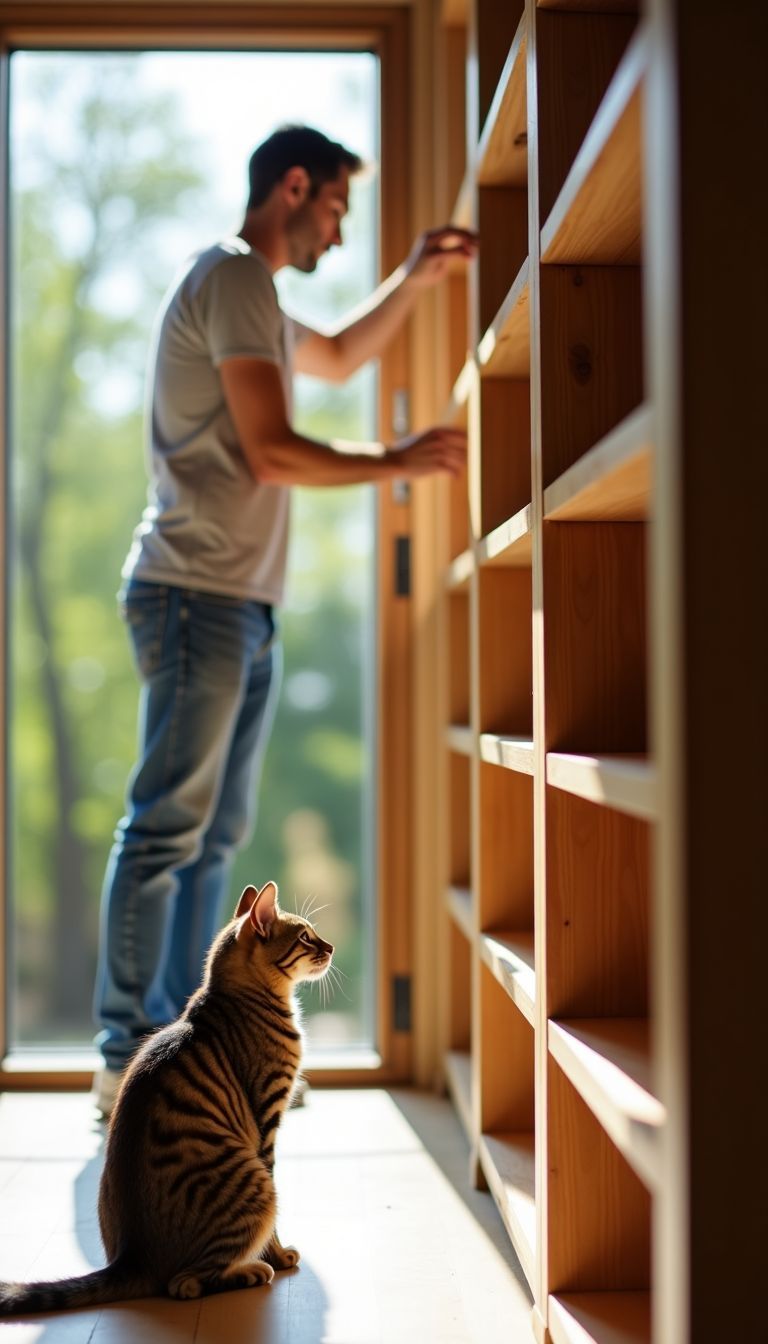
Outdoor cat shelves need care. Clean them often to keep them safe and fun for your cat. Check for loose boards or damage too… Fix any problems right away, so your furry friend stays happy on their climbing wall.
Use weatherproof materials to help them last longer against rain and sun.
Regular cleaning and inspection
Regular cleaning is key for outdoor cat shelves. I check them every 2-3 weeks. This helps keep my cats safe and healthy. I look for dirt, loose wood, or anything broken. It's important to fix issues right away.
I also clean surfaces often. A simple wipe down removes dust and germs. Weather can wear things out too, so I inspect the materials used in shelves regularly. Keeping everything in good shape makes playtime fun and safe for my furry friends!
Weatherproofing materials
Cleaning and inspecting your outdoor cat shelves is just the start. Weatherproofing materials are crucial for keeping everything safe and durable. I used metal panels instead of plastic ones to boost strength against bad weather.
These metal sheets help shield my cat from rain, wind, and snow.
The wooden structure also needs protection. I stained it to guard against moisture and UV rays. This keeps wood looking good longer. Hardware cloth covers the sides and roof too, adding security while allowing airflow.
Using these strong materials ensures my feline friends can enjoy their climbing adventure… no matter what Mother Nature throws at us!
Conclusion

Building an outdoor cat climbing wall is a fun project. Your furry friends will love the new adventures. They can jump, climb, and play safely outside. With colorful shelves and cozy spots, their days will be filled with joy.
Let’s create a space that keeps them active and happy!

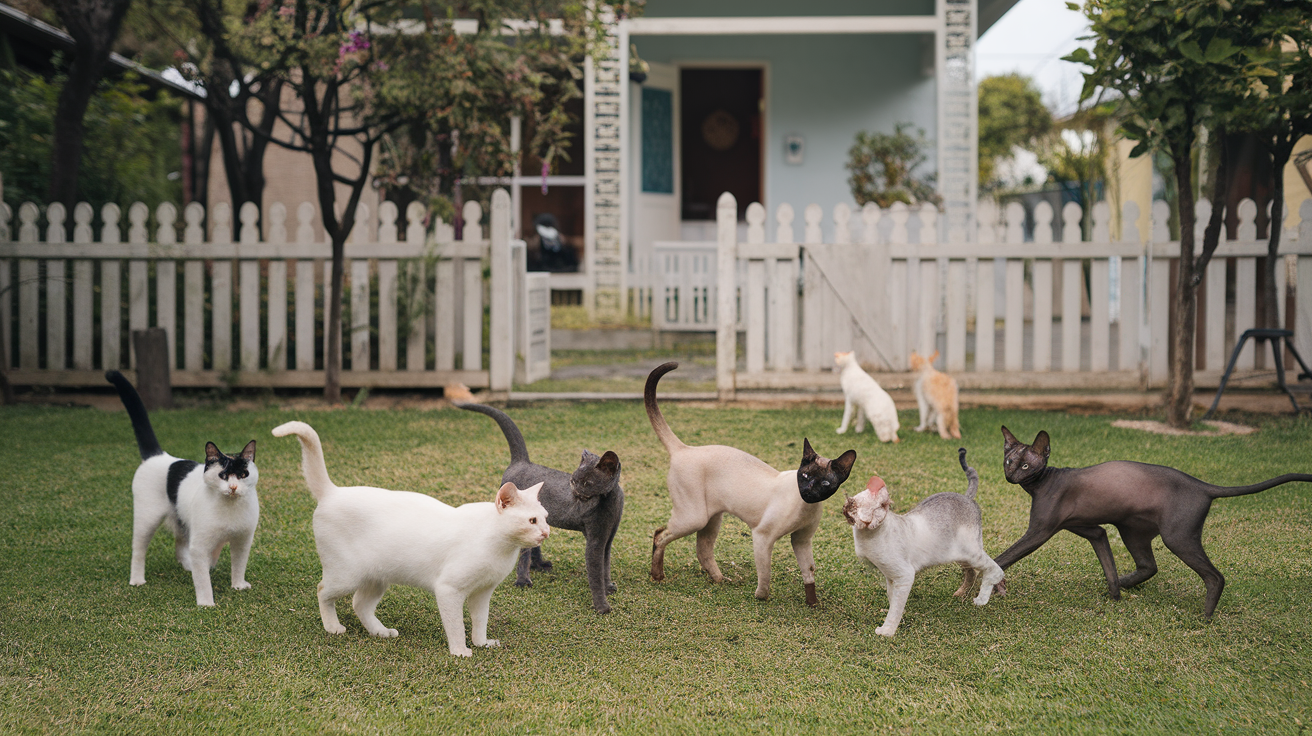




Leave a Reply